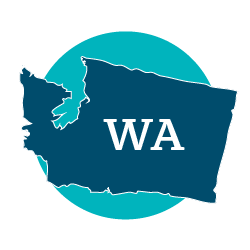If you are not a broker or consultant, explore our content for plan members and families, employers, or dentists and dental offices.
Washington Paid Family and Medical Leave (WA PFML)
Sun Life is eager to meet your Washington PFML needs for Self-Insured voluntary plan administration. Sun Life's WA PFML plan integrates with Short-Term Disability, featuring one claims number for your employees’ medical event, one case manager, one claim submission, and integrated reporting for employers.
Please speak to your Sun Life Sales Representative for more information.
The Washington Employment Security Department (ESD) is the agency responsible for administering the PFML law. Information from the ESD can be accessed here and the state has created a PFML website that can be accessed at www.paidleave.wa.gov.
This site is created for our broker and employer Clients to help them comply with employer responsibilities under the WA PFML law. Please visit this site often for updates.
Quick Facts
Benefit Duration
- 12 weeks for bonding, care of family member, and military exigency
- 12 weeks for employee’s own serious health condition
- Up to 16 weeks combined maximum
- Additional 2 weeks for pregnancy incapacity
- Up to 7 calendar days for child bereavement
Reasons for Leave
- Employees own serious health condition
- Bonding (birth, adoption, or foster-care placement)
- Care for a family member with a serious health condition
- Child bereavement within a year of the birth or the placement of the child for adoption or foster care
- Qualifying military exigency as defined by the federal FMLA
Maximum Weekly Benefit
- $1,427 for 2023
- $1,456 for 2024
Sun Life is committed to providing you with the most up-to-date information as it becomes available. For an in-depth look into recent updates and changes, click below.
Frequently Asked Questions
Yes. Sun Life is eager to meet your Washington PFML needs for voluntary plan administration (administrative services only). Here is information about transferring from the state plan to a voluntary plan. You may also access the state’s Voluntary Plan Guide.
Employers:
All employers with one or more employees, excluding:
- Federal employees
- Self-employed people
- Employees of businesses located on tribal land
- Employees covered by certain collective bargaining agreements
Union members who have collective bargaining agreements that haven’t been reopened or renegotiated, or have expired since October 19, 2017, may not be eligible for Paid Family and Medical Leave.
Visit www.paidleave.wa.gov for information.
Employees:
Update: According to paidleave.wa.gov, if an employee was denied for not having worked the required 820 hours due to COVID-19, and would have used Paid Leave Jan. 3, 2021 or later, they can request a review of this decision starting August 1, 2021.
In a voluntary plan, a covered employee is eligible when they have been in employment for at least eight hundred twenty hours during the qualifying period and in employment with that employer for at least three hundred forty hours; or was covered by an approved voluntary plan through their most recent previous employer in the employee's qualifying period.
Employees working for an employer with a voluntary plan who have not yet met eligibility requirements for that plan are eligible for benefits under the state plan so long as all other requirements are met.
The benefit amounts for WA PFML are as follows:
- The benefits are paid at 90% of the employee’s wages, up to 50% of the state’s average weekly wage (SAWW).
- Any portion of the employee’s wages that exceed 50% of the SAWW will be paid at 50%.
- The minimum benefit will be $100 or the employee’s average weekly wage if it’s less than $100.
- The maximum weekly benefit amount is $1,427 for leaves in 2023 and $1,456 in 2024.
Yes, there is a waiting period of the first seven consecutive calendar days beginning with the Sunday of the first week an eligible employee starts taking PFML. An employee satisfies the waiting period if the employee takes at least 8 consecutive hours of leave during the first week of the employee’s PFML. Under the WA PFML, 8 consecutive hours is the minimum claim duration.
An employee is not entitled to paid benefits during the waiting period.
Employees must meet only one waiting period per claim year.
The waiting period does not apply to:
- Family leave taken for bonding after a child’s birth or placement or
- Family leave taken for child bereavement or
- Family leave taken for reasons related to a qualified military exigency.
The waiting period does not reduce the maximum duration of an employee’s available PFML leave. Employees will receive up to a maximum of 16 or 18 weeks of paid leave. Except for the leave reasons stated above, employees are subject to the waiting period and then have the full maximum duration available to them.
Medical leave is any leave from work made necessary by the employee’s own serious health condition*.
Family leave is available:
- to participate in caring for a family member with a serious health condition;
- to bond with employee’s child during the first 12 months after the birth or to bond with the child within 12 months of the placement of child under 18 years of age;
- Child bereavement within a year of the birth or the placement of the child for adoption or foster care; or
- for a qualifying exigency when the employee’s family member is on active duty or has been notified of an impending call or order to active duty in the Armed Forces
*The definition of serious health condition aligns with that used under the federal FMLA. Namely, a serious health condition is an illness, injury, impairment or physical or mental condition involving inpatient care or continuing treatment.
You may use family leave to care for:
- Spouses and domestic partners
- Children (biological, adopted, foster or stepchild)
- Parents and legal guardians (or spouse’s parents)
- Siblings
- Grandchildren
- Grandparents (or spouse’s grandparents)
- Son-in-law and daughter-in-law
- Any individual who regularly resides in the employee’s home or where relationship creates an expectation that the employee care for person and that individual depends on the employee for care.
- Family member does not include individual who simply resides in same home as EE with no expectation that EE care for individual.
An employee is eligible to be restored to the employee’s previous or an equivalent job position with equivalent pay, benefits and other terms and conditions of employment if the employee:
- works for an employer with 50 or more employees;
- has been employed by the current employer for 12 months or more; and
- has worked for the current employer for at least 1,250 hours during the 12 months immediately preceding the date on which leave will commence.
There are limited exceptions for job protection including a key employee provision and instances where the employer is able to show that an employee would not otherwise have been employed at the time of reinstatement. The employer must send written notices, to be delivered to the employee in person or by certified mail, if they intend to deny job restoration and employers must continue health benefits even when denying job protection
Visit www.paidleave.wa.gov for more information.
WA PFML premiums may be shared between employer and employee. Premiums for 2023 are 0.8% of gross wages paid up to the Social Security maximum. Employers may withhold approximately 72.76% of the premium for employee wages.
Small businesses with fewer than 50 employees are not required to pay the employer portion of the premium, but they still collect and submit the employees’ share of the premium, and their employees are fully eligible for the benefit.
An employer that elects to pay all or a portion of its employees’ premiums must give written notice at least one pay period before change in its elected payment.
Yes. Employers may seek approval to meet their obligations of the WA PFML law through a voluntary plan. Please ask your Sun Life Sales Representative for information about Sun Life’s WA PFML voluntary plan.* Here is information about transferring from the state plan to a voluntary plan. You may also access the state’s Voluntary Plan Guide.
*In some states, “voluntary plan” is referred to as “private plan.”
Basic requirements of a voluntary plan include the following:
- It must meet or exceed the benefits of the state plan.
- It must confer the same or better benefits as those provided in the state plan, including but not limited to, providing at least the same length of leave, amount of paid benefits, and job protection during leave.
- It may not cost employees or covered contract workers more than they would be charged in the state plan.
- It must provide for continuation of health insurance benefits for employees during leave.
- It must permit leave to be taken intermittently or on a reduced leave schedule, with the weekly benefit amount being prorated.
- It must provide written notice to the covered individual of any adverse determination under the voluntary plan as to the covered individual’s rights under the voluntary plan.
- It must provide for an appeals process with the voluntary plan administrator before the covered individual can appeal a denial of benefits to the ESD.
- It must expressly state that all presumptions shall be made in favor of the availability of leave and the payment of benefits.
Yes. While the WA PFML law creates certain paid benefits for leave because of an employee’s own health condition or for covered caregiving reasons, the WA PFML law is not intended to replace benefits provided by employers through Short Term Disability (STD) plans and programs. It is important to know that cancelling STD benefits could leave your employees unprotected if they become disabled for these reasons:
- Benefit amount for higher-income employees. The WA PFML max weekly benefit may be insufficient for high-income earners who require greater income replacement.
- Consequences of combined 16 weeks of family and medical leave. If an employee takes 16 weeks of family leave in a 12-month period, the employee may be left without income replacement for their own serious health condition in the same timeframe.
- Impact of intermittent leave. WA PFML can be taken intermittently so an employee may substantially reduce and/or exhaust their benefits be left without income replacement protection if they become seriously and continuously disabled thereafter.
- Short-term disability may offer additional features and benefits. STD policies may include employee-facing features that improve their experience: first-day hospitalization, survivor benefits, and, most important, return-to-work and vocational rehabilitation programs. Employees can still access these features even if they are approved for both WA PFML and STD.
Sun Life is committed to assisting you in complying with the requirements of the new WA PFML law and with providing valuable employee benefits to your employees. We also offer leave and accommodations administration services. Please reach out to us and we will evaluate your benefit plans and compliance needs from a holistic perspective and provide guidance and services to meet your and your employees’ needs.
-
Questions?
Please call your Sun Life Client Relationship Executive.
If you have fewer than 100 employees, please call Client Services at 1-800-247-6875.
Sun Life’s self-funded or administrative-services-only WA PFML solution will be administered by Sun Life Assurance Company of Canada (Wellesley Hills, MA). This service is not insurance.
SLPC 30705 7/22 (Exp 07/24)



